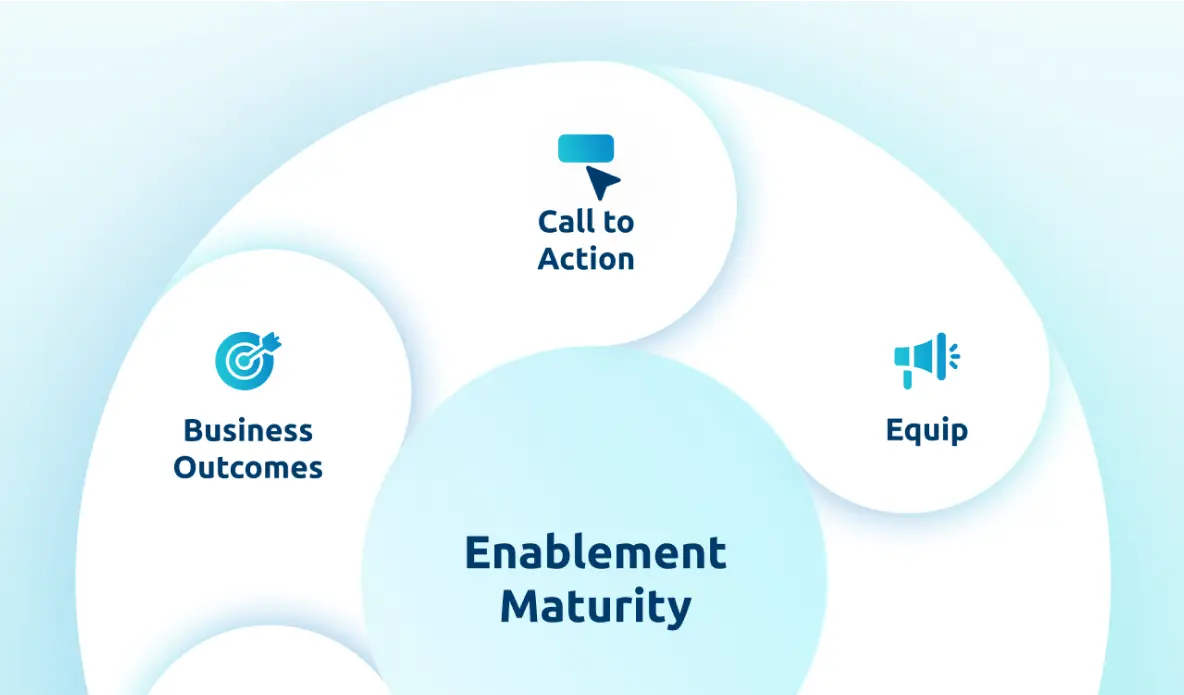According to data from Gartner, organizations that prioritize revenue enablement are 75% more likely to exceed their revenue growth targets. So how can you drive impact with an effective enablement strategy?
Shawnna Sumaoang: Hi, and welcome to the Win Win Podcast. I am your host, Shawnna Sumaoang. Join us as we dive into changing trends in the workplace and how to navigate them successfully.
Here to discuss this topic is Lou Keane, the senior vice president of revenue operations at GWI. Thanks for joining us, Lou. I’d love for you to tell us about yourself, your background, and your role.
Lucrezia Keane: It’s great to be here. I joined GWI about 11 years ago, previous to that, I was working for another research company called Kantar. I started off as an individual contributor on the account management side and worked my way up there for the first six years. When I joined GWI 11 years ago, it was very much a startup. There were 13 people in the whole business and I joined to set up the account management team.
And then grew that team from myself as a player-coach and one other rep, to having 15 account managers. We launched a customer success team as well so then high antenna customer success reps. And drove the growth of the account management, renewal, and expansion of existing accounts.
By then, my role pivoted and changed a little bit. So I started looking after what we define as sales excellence, which covers everything around enablement and operations. This is at the point when we brought Highspot on board, and my role now is a little bit more focused on revenue growth. So, looking after SDRs, channel, and partnership solution partners, which are essentially our sales engineers but spanning still some enablement operations.
SS: We’re so excited to have you here, Lou. You had an opportunity to work across multiple disciplines, as you mentioned in your introduction, from account management to sales excellence and revenue growth, based on this experience, what do you see as the strategic value of enablement for revenue teams?
LK: Absolutely. From my perspective, the main thing about enablement is helping to improve efficiency and drive productivity. Whether it’s updating processes, creating new processes bringing on tools that enable you to automate certain tasks, driving efficiencies, or having the analytics and the background to really understand the impact of those tools and the impact on the business.
Then the last bit for me is content. Having the right content for the reps, whether it’s training type of content or more of the sales collateral and sales assets. For me, enablement looks at processes, tools, and content, and to drive efficiency and productivity.
SS: I couldn’t agree more. Now, thinking back before you had Highspot, what were some of the challenges your teams were facing?
LK: We had a few. So, as a startup and then a scale-up, there were lots of pieces of content saved in lots of different places. We moved to Google Drive, and it was very difficult for reps to find the latest piece of content and the most appropriate for certain conversations with different types of clients.
It was difficult to measure client engagement with that content. Providing a marketing team or strategic insights team with feedback on how clients were engaging and what really worked in the sales process—those are the main challenges. Then, streamline training and onboarding. It was very manager-led, done slightly differently, depending on the manager, depending on the team. So streamlining all of that was a key aspect that we needed to improve.
SS: I think we all can definitely relate. And at that time, I believe you were leveraging a different enablement platform.
What was the impetus for deciding to make a change and find another solution?
LK: At the time we had an LMS. But I don’t think it was being used as widely, or as effectively as it needed to be. It was also because it wasn’t owned within the revenue team—adoption wasn’t great—and then we used Google Drive for managing a lot of our content, which isn’t the best place to manage content.
Yeah, really fun finding a solution that helped with content management and tracking, but also coaching and training. As part of the evaluation process, we spoke to a number of different companies, including Highspot. But what really made Highspot shine compared to some of the other companies that we were evaluating was really the ability to do both of those things and do them well.
We spoke to companies that were really strong in the content management part but didn’t have the coaching and training element and vice versa. So, having the combination of the two was really key for us.
SS: I love that and I’m glad you did. Part of your team’s focus when bringing on Highspot was building out training programs.
Why was this a key focus for your business and how did Highspot help you to build effective training?
LK: It was a key focus because we were growing really rapidly. We were hiring lots of new people and realized that maybe our ramp time was a little bit slower than we wanted it to be. As I mentioned earlier training was very manager-led during isolation by different teams and different managers.
Some were better at it, some weren’t as great. So really having a consolidated unified way of training the different teams, bringing them into Highspot, building out Sales Plays, building out all of the different learning paths, customizing those learning paths based on different roles or teams that they were working on.
It enabled us to be a lot more effective and efficient with the training that we were building, and how that was being delivered to our reps with different types of content, in different types of formats. We brought in LinkedIn Learning videos and had our own, we mixed it up with some face-to-face sessions and some self-learning and had different quizzes. So it made it much more engaging and interactive than we had before. It also enabled reps to go back to it. So it wasn’t a kind of one-and-done type scenario, but it enabled them to, if they weren’t quite clear on something, to refer back to it. But, I think one of the key things that we’re still leveraging now—and it’s a really easy way for reps to understand new processes or products—is Sales Plays.
It really helps give the rep a streamlined, really concise view of, for example, what the product is, how to speak to customers about it, what use cases it answers, how will customers be leveraging it, and really helps them in their sales journey.
SS: You’ve done an amazing job. Your team has seen incredible adoption since implementing Highspot, including 88% recurring usage. What were some of your best practices for driving adoption when you first implemented the new platform?
LK: We did a lot of training, and a lot of roadshows team by team to really address the needs of every individual team. There was a lot of drop-in sessions following the first launch, and we spent a lot of time showing the value of Pitches and Sales Plays and why it was a much quicker and better way of finding out more about a product. But also, with the Pitches, is sharing content with clients and prospects, understanding how those clients and prospects were engaging with those.
It was so easy to show the value of things like Pitches to the sales reps because for an account manager where the contract’s coming up for renewal, they could share that through a pitch and they could see: A, has a key decision maker engaged with it? Have they shared it with anyone else? Who are they sharing it with?
It gives the reps the right time to reach out to that person. Once they know they’ve had the time to consume that content, then they reach out to them, rather than it being completely blank and chasing people endlessly. So that was really helpful.
We set up Spot owners to keep things up to date, that was critical. And obviously, one of the issues we had previously was that a lot of content wasn’t up to date. So having Highspot and having Spot owners who were responsible for uploading new things, and removing when things were out of date built that trust with the team as well.
They know that when they go in there, they have access to the latest information, and I think we constantly share updates on new content available. Everyone across the organization has really adopted it; our CRO will constantly share links to assets that are in Highspot. So again, it’s driving that usage and that engagement with the tool as well.
SS: I love that. In addition to adoption, what are some of the business outcomes you saw after implementing Highspot?
LK: The first one was really about ramping faster. New joiners that were joining GWI were able to, through the different kinds of learning paths, onboard themselves a lot quicker, and had better results.
We see that kind of on an ongoing basis with our SDR team, as well. They’re running faster than they ever did, hitting their targets quicker. They have better knowledge of how to engage with the customers and better knowledge about new products. So it’s not just for new reps, but also existing reps who want to upskill themselves. Being able to do that as and when they need, and not be too constrained to a training session that’s being booked in four to six weeks’ time.
If there’s something new that’s already been released, they can access that content straight away. Those were the main things that we saw. The other thing was better success rates in terms of closing deals faster because of the Pitches and engaging at the right moment, I say those are the main things.
SS: Fantastic. And ultimately, how have your teams overcome the challenges they previously faced and how did Highspot help?
LK: One of the things is, it made it a lot easier to find the right content. We did a lot of work on filtering, but some of the developments that Highspot made by making the search functionality a lot easier and a lot more intuitive, really helped our reps and our teams find the right content a lot quicker.
Being able to track engagements in general, just having a better-informed sales team through the content that’s in there. And then again, having less out-of-date content really streamlines the process, and makes sure that the right content is in the hands of the right people and the right clients.
And they’re not sharing stats or information that’s 12 months out of date, because that can really impact the trust you have with a client or a prospect.
SS: I love to hear that. Lou, last question for you, looking toward the future of GWI, what do you hope to achieve in the year ahead and how can Highspot help?
LK: I think that so many features that Highspot has, we could actually embed a lot more and do a lot more of. One of the things that we really want to look at is how we embed Highspot content training and learning in Salesforce more. So that when reps are in Salesforce, they have that content surfacing.
We’ve done a little bit of it, but it’s probably not as well organized as we’d like. We’re launching a new LMS platform and I think integrating the LMS with Highspot will be key. We’d like to do a lot more with some of the new AI features that you’ve launched and also leverage the scorecards more.
So there are definitely a few features that we need to do more of. But again, it’s great to have a platform like Highspot that really helps us move forward with some of these things.
SS: Thank you so much for joining us, Lou. I really appreciate it.
LK: No, it’s great to be here and it’s lovely talking to you.
SS: To our audience, thank you for listening to this episode of the Win Win Podcast. Be sure to tune in next time for more insights on how you can maximize enablement success with Highspot.




